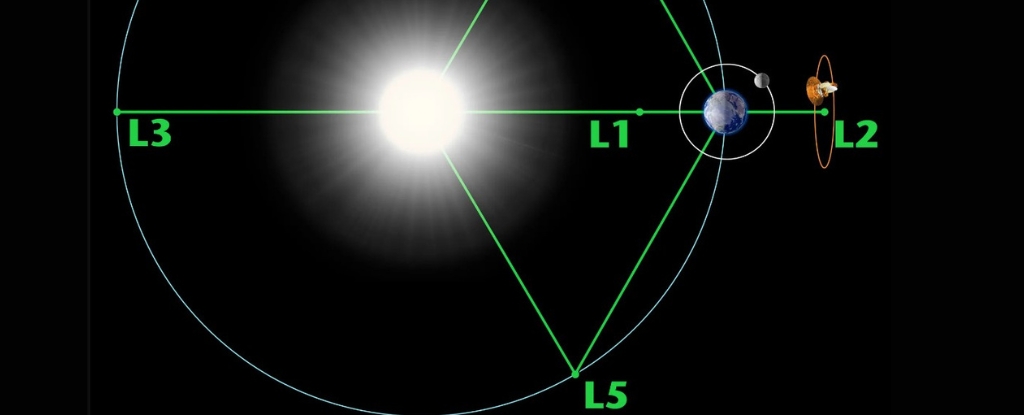
Witness an intensifying ‘space race’ as the US and China engage in a rivalry within the realm of space exploration, with Lagrange points taking center stage as the emerging battleground.
Bearing the name of the esteemed astronomer Joseph-Louis Lagrange, Lagrange points signify specific locations in the vast expanse of interplanetary space. At these points, the gravitational forces exerted by two celestial bodies, such as the Earth and the Sun, harmoniously counterbalance the centripetal force required for a smaller object to maintain a stable orbit in the space between them.
Within the Sun and Earth-Moon system, five distinct Lagrange points, denoted as L1 to L5, manifest as outcomes of these distinctive gravitational interactions.
Positioned at fixed locations 60 degrees ahead and behind the Earth (including the Moon) along its orbit around the Sun, L4 and L5 offer remarkable stability. This characteristic renders them optimal ‘parking’ zones for satellites and telescopes.
Spacecraft stationed in these areas require minimal fuel adjustments, enabling prolonged observation of our planet and its moon. These Lagrange points provide a constant vantage point for monitoring Earth’s weather patterns.
The absence of atmospheric interference and the proximity of L1 and L2 to the Moon enhances the appeal of these spots as prime locations for parking spacecraft. The strategic control of these positions confers a substantial advantage in the realms of space research, communications, and surveillance.
When viewed from the Sun’s perspective, L2 is situated ‘behind’ Earth at a distance of 1.5 million kilometers (932,000 miles). Orbiting the Sun at the same speed as Earth, it is positioned approximately four times farther away than the maximum distance the Moon reaches from Earth.
Positioned beyond the Moon from Earth’s viewpoint, L2 offers a clear and uninterrupted vista of deep space, establishing it as a prime site for sensitive telescopes such as JWST.
China has successfully deployed the Queqiao relay satellite to L2 within the Earth-Moon system. This satellite serves as a crucial communication link for the Chang’e 4 lunar probe, marking the historic achievement of being the first probe to land on the far side of the Moon.
The United States is actively targeting L2 within the Earth-Moon system, outlining missions such as the Gateway lunar outpost scheduled for the late 2020s.
“L2 is specifically important because of its visibility to the far side of the Moon,” space systems engineer Laura Duffy told Eric Berger at Ars Technica. “We cannot see that from the Earth, and China is headed there.”
The recent focus on the economic and technological competition between the United States and China is highlighted in a report from a bipartisan committee in the House of Representatives. The report aims to “fundamentally reset” the relationship and proposes nearly 150 policy recommendations.
An analysis of the ongoing economic and technological rivalry between the United States and China is the focal point of a recent report from a bipartisan committee in the House of Representatives. The committee aims to “fundamentally reset” the relationship, presenting nearly 150 policy recommendations to address the dynamics between the two nations.
Following a year-long investigation, the report delves into the longstanding rivalry between the nations, a conflict that has persisted since China acceded to the World Trade Organization in 2001.
“NASA and relevant Department of Defense funding is critical to ensure command and control in the space domain,” the report states, “establish dominance in multilateral space governance, and spur scientific discovery and American innovation.”
The recommendations cover a wide range of areas, with one notable suggestion standing out, particularly in the realm of space. As outlined in the report, Congress is advised:
“Fund NASA’s and the Department of Defense’s programs that are critical to countering the CCP’s [Chinese Communist Party] malign ambitions in space, including by ensuring the United States is the first country to permanently station assets at all Lagrange Points.”
China’s space program has made significant strides in recent years, exemplified by accomplishments such as the Chang’e 5 lunar sample return mission and the forthcoming Chang’e 6 mission to the Moon’s south pole. These endeavors mark substantial advancements in China’s space exploration endeavors.
China’s operational space station, Tiangong, is actively functioning, with plans to send taikonauts (astronauts) to the Moon soon.
“The CCP understands well the need for space-based operations and is developing formidable space capabilities to challenge US dominance in this domain,” the committee report says.
Both nations are actively advancing technologies for deep-space exploration, utilizing Earth-Moon system Lagrange points as strategic milestones for future missions to Mars and beyond.
Beyond the rivalry in space exploration between the US and China, numerous countries are engaged in collaborative efforts on initiatives such as the International Space Station. These endeavors persistently contribute to advancing our comprehension of the Universe.
The global community shares a keen interest in Lagrange points, with entities such as the European Space Agency actively developing their own missions to these strategic celestial locations.
The concentration of the new space race on Lagrange points presents a blend of concern and fascination. However, it promises to be intriguing to observe how these points will be leveraged to propel advancements in space exploration.





